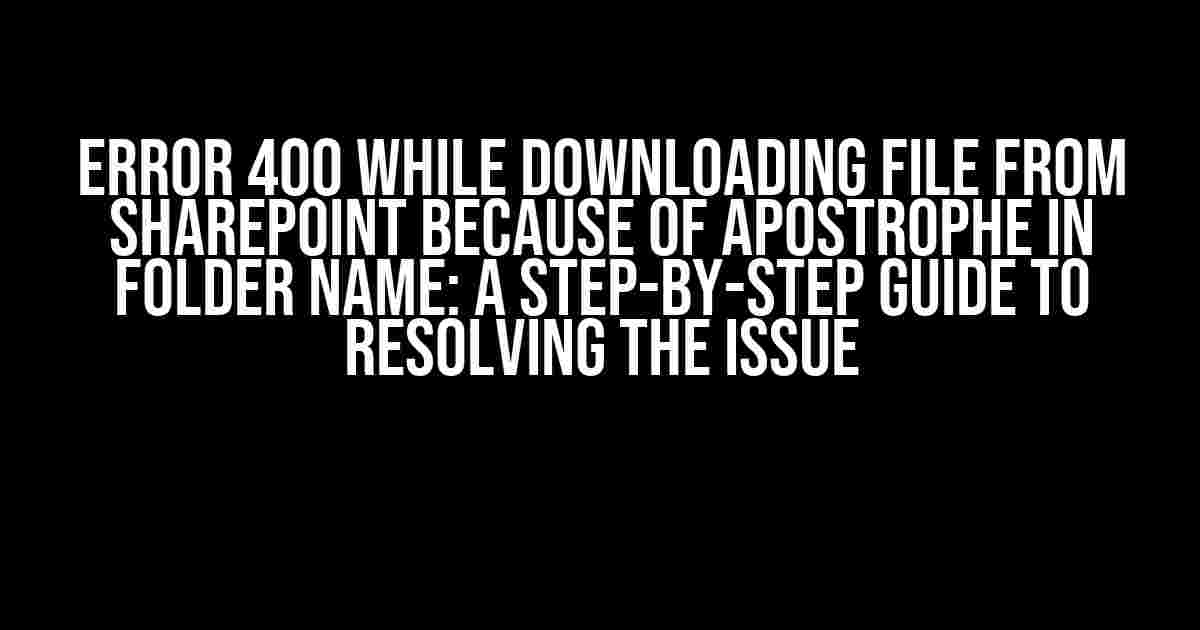Are you tired of encountering the frustrating Error 400 while trying to download files from SharePoint? Do you suspect that the pesky apostrophe in your folder name might be the culprit? You’re not alone! In this comprehensive guide, we’ll delve into the root cause of the problem and provide you with a straightforward solution to download your files successfully.
What’s causing the Error 400?
The Error 400 is a generic error code that indicates a bad request. In the context of SharePoint, it usually occurs when there’s an issue with the URL or the request itself. In this case, the apostrophe in the folder name is the prime suspect. SharePoint’s REST API has a peculiar way of handling special characters, and the apostrophe is one of them.
Understanding the Role of Apostrophes in SharePoint URLs
In SharePoint, URLs are used to access files and folders. When you create a folder with an apostrophe in its name, SharePoint will encode the URL using URL encoding (also known as percent-encoding). This process replaces special characters like apostrophes with their corresponding encoded values.
Original Folder Name: John's Folder Encoded URL: /sites/mysite/John%27s%20Folder
The encoded URL might look like a jumbled mess, but it’s essential for SharePoint to correctly identify the folder. However, when you try to download a file from this folder, the encoded URL can cause issues.
Resolving the Error 400: A Step-by-Step Solution
Don’t worry; we’ve got a simple and effective solution to help you download your files successfully. Follow these steps to resolve the Error 400:
-
Identify the Problematic Folder
Locate the folder with the apostrophe in its name. You can do this by checking the URL of the folder in your browser’s address bar.
-
Encode the Apostrophe Correctly
Instead of using the encoded URL with the %27, you’ll need to replace the apostrophe with its corresponding Unicode escape sequence. The Unicode escape sequence for an apostrophe is \u0027.
Original Folder Name: John's Folder
Corrected URL: /sites/mysite/John\u0027s Folder
-
Update the URL in Your Download Request
Modify the URL in your download request to include the corrected folder name with the Unicode escape sequence. You can do this using a tool like Postman or by updating your code.
-
Verify Your Download Request
Send the updated request to download the file. If everything is correct, you should be able to download the file without encountering the Error 400.
Alternative Solutions
If the above solution doesn’t work for you, or if you’re dealing with a large number of folders with apostrophes, you might want to consider the following alternatives:
-
Rename the Folder
Simply rename the folder to remove the apostrophe. This might be the quickest solution, especially if you have a small number of folders.
-
Use SharePoint’s REST API Explorer
Utilize SharePoint’s built-in REST API Explorer to generate the correct URL for your download request. This tool can help you navigate the complexities of SharePoint’s API.
-
Implement a URL Encoding Solution
Develop a custom solution using your preferred programming language to handle URL encoding correctly. This might involve using libraries or frameworks that can handle special characters efficiently.
Common Pitfalls and Troubleshooting Tips
When dealing with the Error 400, it’s essential to be aware of common pitfalls that might hinder your progress:
| Pitfall | Troubleshooting Tip |
|---|---|
| Incorrect URL encoding | Verify that you’re using the correct Unicode escape sequence for the apostrophe (\u0027). |
| Inconsistent folder naming conventions | Establish a consistent naming convention for your folders to avoid special character issues. |
| Outdated SharePoint version | Ensure that your SharePoint version is up-to-date, as newer versions might have improved support for special characters. |
Conclusion
In conclusion, the Error 400 while downloading files from SharePoint due to an apostrophe in the folder name can be resolved by correctly encoding the URL using the Unicode escape sequence. By following the step-by-step guide and being aware of common pitfalls, you should be able to download your files successfully. Remember to stay calm, and don’t let that pesky apostrophe get in the way of your productivity!
Still stuck? Feel free to share your experience or ask for further assistance in the comments below. Happy downloading!
Here are the 5 Questions and Answers about “Error 400 while downloading file from SharePoint because of apostrophe in folder name” in HTML format:
Frequently Asked Question
Error 400 while downloading a file from SharePoint can be frustrating, especially when it’s due to something as seemingly innocuous as an apostrophe in a folder name. But don’t worry, we’ve got you covered!
Why do I get an Error 400 while downloading a file from SharePoint?
An Error 400 typically occurs when SharePoint’s URL encoding rules are violated, often due to special characters in folder or file names. In this case, the apostrophe in the folder name is the culprit.
Is it only the apostrophe that causes the Error 400?
No, it’s not just the apostrophe. Other special characters like ampersands (&), question marks (?), and pound signs (#) can also cause URL encoding issues and lead to Error 400.
Can I rename the folder to resolve the issue?
Yes, one solution is to rename the folder, replacing the apostrophe with a different character or removing it altogether. This will ensure that the folder name conforms to SharePoint’s URL encoding rules.
Are there any other workarounds if I cannot rename the folder?
Yes, you can try using the SharePoint REST API or CSOM (Client-Side Object Model) to download the file. These methods allow for more control over URL encoding and can help bypass the Error 400.
How can I prevent similar issues in the future?
To avoid similar issues, it’s essential to ensure that folder and file names comply with SharePoint’s URL encoding rules. Use only alphanumeric characters, hyphens, and underscores, and avoid special characters altogether.




